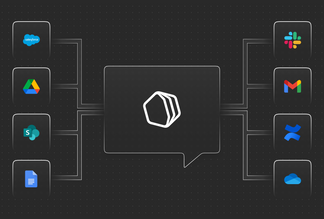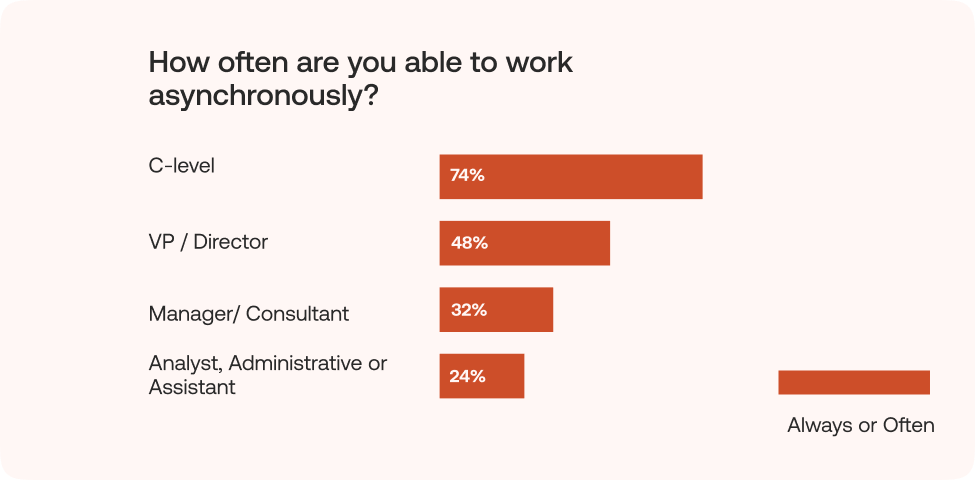
What is asynchronous work? (And how many of us are doing it?)
As we discussed in the last blog, expectations around flexibility at work have changed dramatically in recent years. Workers now expect more freedom to choose not just where, but when they work. As part of this shift, interest in ‘asynchronous working’ has risen substantially, as companies attempt to adapt to the new reality of remote work.
However, a new report from Qatalog and GitLab found that the majority of workers still aren’t able to work asynchronously, and most don’t even understand what the term means. The research also discovered that the ability to work ‘async’ is often determined by seniority, suggesting the newfound flexibility isn’t being shared fairly.
But first, what is asynchronous work, and what are the advantages?
What is asynchronous work and why is it an improvement
Asynchronous work describes when people on the same team complete their work during different times of the day on their own timetable, and without the expectation of immediately responding to others, as you might do during a meeting or while using Slack.
There are a number of different reasons that asynchronous work is considered to be an improvement on the status quo:
- Deep work - With far fewer meetings and no requirement to respond to messages immediately, workers can avoid constant distractions, which allows for ‘deep work’. Being in the zone of deep work also improves productivity and reduces the “always-on” anxiety and stress.
- A system for global teams - a rise in teams being distributed globally means that some team members will be working in different time zones. Waiting for colleagues to wake up before you can get anything done just isn’t very efficient. Async communication methods, tools, and culture make it easier to stay updated, informed, and get work done, even when you’re working on different schedules.
- Live first, work second - async gives employees the freedom to fit work around their lives. Without the need to be online just in case, you can properly manage a schedule that involves going to the gym, picking up the kids, and getting that report done on time. This should result in happier, more fulfilled employees.
Tackling misconceptions
Although it’s not a new way of working, async is still uncommon enough that some don’t understand it, meaning there are some misconceptions.
- You’ll never speak to your colleagues - Asynchronous working doesn’t mean you never have a chat with your colleagues. It means that you practice deliberate communication. If your colleagues are not working the same schedule as you, then you need to be more thoughtful about the information you share, so that they are able to pick up where you left off, without the need to ask you follow-up questions. This could be an email, Slack, or a tool like Qatalog, but deliberate communication requires that you increase the quality of communication so that your colleagues can get things done without having you “on-call”.
- No more meetings - If done right, async should mean there’s less of a requirement for meetings, but that doesn’t mean they never happen. What changes is that meetings are no longer the default for whenever someone wants to have a discussion or provide an update. Instead, meetings are typically reserved for specific situations where synchronous communication is a necessity or desirable, often for consolidating work done async, or for more social interactions. Companies with experience working in this way will often have guidelines around when to use meetings and when not to.
Async privilege is a problem
Despite all of the advantages, just 9% of knowledge workers said they ‘Always’ worked asynchronously, and a further 24% said they ‘Often’ worked asynchronously, leaving almost two-thirds of people out of the benefits of asynchronous work. But when you dig deeper into the numbers, a pattern starts to emerge.
74% of employees at C-level - CEOs, CTOs and COOs, etc - admit to enjoying asynchronous working practices either ‘Often’ or ‘Always’, compared to just under half at 48% of those at Vice President or Director level. Further down the hierarchy, only 32% of those at Manager or Consultant level enjoy working asynchronously and for Analyst or Administration roles it’s only 24%.
It’s clear that managers either don’t trust those that work for them enough to work asynchronously, or the tools and culture aren’t in place to support everyone working this way. C-Suite execs know they can work to their own schedule, perhaps because they don’t fear questions from their team about where they are, or what they’re doing.
There’s no good excuse for this kind of disparity today. For asynchronous working across an organization to be successful, it needs to apply to everyone. Business leaders need to put in the effort, build a framework, and encourage a culture that offers the benefits of async work to everyone.
Most people don’t know what async actually is
The move to async working for most of the workforce is going to be substantial. Most people know and understand working synchronously - they’ve been doing it for decades - but there are a number of barriers to adoption which we discuss in greater detail in our upcoming blog post about digital presenteeism in the workplace.
However, the greatest obstacle is that people simply don’t know what async working is, or that it is even an option. Only 15% of the respondents understood what asynchronous working is while 40% of those surveyed had never heard of it.
If you don’t know there’s a better way of working, it’s going to be difficult to make the shift. By contrast, once you understand the principles and methods behind asynchronous working, you'll see that it opens up options for flexibility, makes balancing work and life much, much easier, drives efficiency, and even provides a more profound enjoyment of your work.
But you will also be in a much better position to make that change within your organization. You’ll begin to recognize when a meeting could be a written update, or how a Slack message could replace a phone call. You’ll start to understand the importance of creating a culture of documentation so that you don't have to ask for information, but have it readily available when you need it. This, in turn, will make you think more about what you need to provide to others for them to get their work done.
How do we get started?
Working async is not something that we’ve been trained to do. The vast majority of us have worked synchronously most of our working lives, and shifting to an asynchronous culture requires planning, patience, and deliberate practice. It doesn’t help that lots of our technology is biased towards real-time communication. Slack, Teams, and Zoom all demand our attention and pull us back into our synchronous ways. Even things like our workflows, processes, policies, and often employment contracts all point towards synchronous work.
That’s why it can be a challenge for any organization to move to an asynchronous way of working, but the transition is critical if we want to continue enjoying flexibility in the way we work. The very first step is one of education and advocacy. People need to understand that there’s a better way of working before making the leap. Talk to your managers, the people team, and your colleagues about it. It doesn’t need to be an all-or-nothing big bang, you can begin to employ some of the mechanics of asynchronous working without waiting for the green light.
Communication and planning
One of those mechanics is around communication. Start by making more of an effort to communicate in a deliberate and thoughtful way. Hopefully, this will show that it’s possible to reduce the requirement for meetings in certain instances, and encourage others to do the same.
The second is planning, which builds on the communication mechanism. Planning requires you to set expectations around the work you or your team need to do. What are you trying to achieve and by what date? What expectation of quality or quantity is there around the work? Write these things down and communicate them to your colleagues, as this will reduce the likelihood of urgent requests and late-night questions. You’ll also need to make sure your colleagues know what you need to get your work done and give them a heads up well ahead of time.
Using the right tools, in the right way
Finally, to create and maintain the asynchronous future that we all deserve, the tools we use must support this new way of working. On-demand, real-time chat, and video tools have their place but, when it comes to working asynchronously, choosing the right technology is a big part of the puzzle.
At Qatalog, we live and breathe an asynchronous culture. There is a strong bias towards asynchronous communication and we ask everyone to model the behaviors we want to see, while being mindful of our colleagues' work patterns. We write things down, share them, and make them accessible. The Qatalog platform is at the heart of this, tying all of our work and communication together, and we’re more productive than we’ve ever been.





